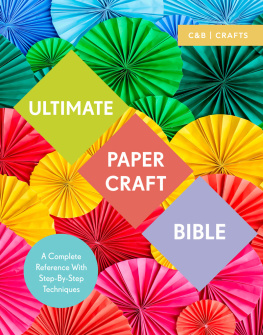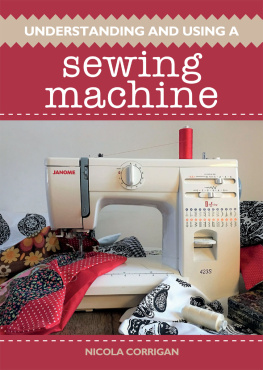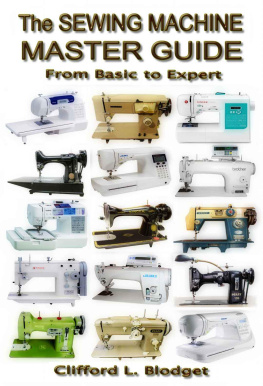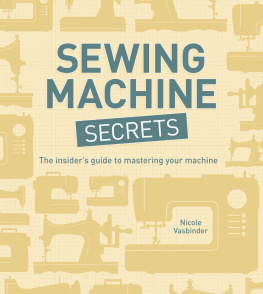



SIMPLICITY HOW TO USE A SEWING MACHINE
Published as eBook in the United Kingdom
in 2015 by
Collins & Brown
1 Gower Street
London, WC1E 6HD
An imprint of Pavilion Books Company Ltd
Copyright Pavilion Books Company Ltd 2010
All rights reserved. No part of this publication may be reproduced, stored in a retrieval system, or transmitted in any form or by any means electronic, mechanical, photocopying, recording or otherwise, without the prior written permission of the copyright owner.
eISBN 978-1-910231-67-8
This book can be ordered direct from the publisher at www.pavilionbooks.com
AUTHOR ACKNOWLEDGMENTS
With thanks to everyone at Collins & Brown for their support of this book. Thank you to Kuo Kang Chen for the excellent illustrations, Cheryl Brown for her thorough editing and Smith & Gilmour for the stylish design. I would also like to thank Deborah Shepherd, Ron Stower and Maureen Brown at Janome, Stephen Bogod at Singer and Dawn Cowling at Bernina for all their help with technical information and for answering endless questions.
Marie Clayton
CONTENTS
BEFORE YOU BEGIN
Sewing is a practical skill that is useful for running repairs and it can also be a great outlet for your creativity. There are so many interesting fabrics available today, as well as wonderful buttons and trims, that you can make something unique and personal with just a little time and effort.
THE BOOK FOR YOU
Modern sewing machines and sergers have so many exciting features that they can look a bit daunting to a less experienced sewer but these not only make repetitive or complex tasks quick and stress-free, they can also open up a new world of decorative techniques. This book is designed to help you to choose the right machine for you, and then explains how to get the very best from it whatever you want to make.
BUYING THE RIGHT MACHINE
, Knowing Your Machine, begins with how to set up your sewing area for efficient working, and then goes into a guided tour of a typical sewing machine and serger, with details of the main working parts and what they do. It covers the different types of presser foot and needle for the sewing machine and what they are used for. There are illustrated steps for basic techniques such as how to wind a bobbin on your sewing machine, and how to thread up for both the sewing machine and the serger, including how to set the correct tension on the threads for perfect stitch formation.

, Choosing a Machine, will help you to choose the right machine for your needs.
GETTING STARTED
In , Using Your Machine, we get started on sewing, with explanations of how to set up your machine and how to stitch and guide the fabric. A useful stitch glossary covers the basic stitches that are commonly available on the sewing machine and the serger. Troubleshooting sections look at common stitching or operational problems, what might have caused them, and how to put them right. A brief section on fabric covers the different types, and explains how best to handle some special fabrics. The chapter ends with information on other sewing equipment you will need for measuring, marking and cutting, along with a step-by-step basic skills section covering pinning, basting and simple hand-stitching techniques.

, Using Your Machine, will give you the confidence to get started with your new sewing machine.
SEWING TECHNIQUES
The remainder of the book introduces sewing techniques that you can use your machine for. , Decorative Techniques, is all about embellishing techniques, such as machine embroidery, appliqu, patchwork and quilting, including the basic steps for making a complete quilt. At the end of the book is an extensive glossary, which explains all the sewing terms used in the book for quick reference.
LEARNING BY DOING
One of the major benefits of being able to sew is that you are no longer tied to the colors and styles available in the stores you can make whatever you like in whatever fabric you choose. And even if you dont have time to make a complete project from scratch, many of the techniques in this book can be used to personalize store-bought items so they are one-of-a-kind. Learning to sew is the first step into an exciting new world; learning to make the most of your sewing machine will help you to build your skills quickly to achieve professional-looking results. Dont be afraid to experiment on your machine you may find a wonderful new way to accomplish something and even the odd disaster can usually be turned into something different. One of the joys of fabric is that it is so forgiving there arent many types that cannot be unpicked and stitched again.
If you are new to sewing, start by making something quite simple and straightforward that will allow you to concentrate on learning to use your machine and understanding what the different functions will do for you. As you progress in confidence and skill you can move on to more complex projects the only way to become an experienced sewer is by doing lots of sewing!

, Knowing Your Machine, provides essential advice on choosing presser feet and sewing machine needles whatever the sewing task to be undertaken.

outline all the practical tasks you can use your sewing machine for including sewing seams, hemming and making trimmings.

, Decorative Techniques, introduces some of the creative embellishments that your sewing machine can help you to achieve.
CHOOSING A MACHINE

Sewing is an exciting and rewarding pastime that will not only save you money but also allow you to make something that is uniquely yours. Today, it has never been easier to make your own professionally finished soft furnishings, clothes and accessories with a wide range of sewing machines on the market to help you. But how do you choose the right machine for your needs? This chapter will give you all the information you need to help you to decide which is the perfect sewing machine for you.
Next page

















